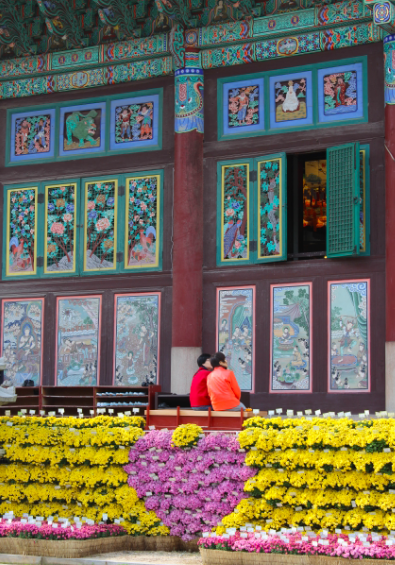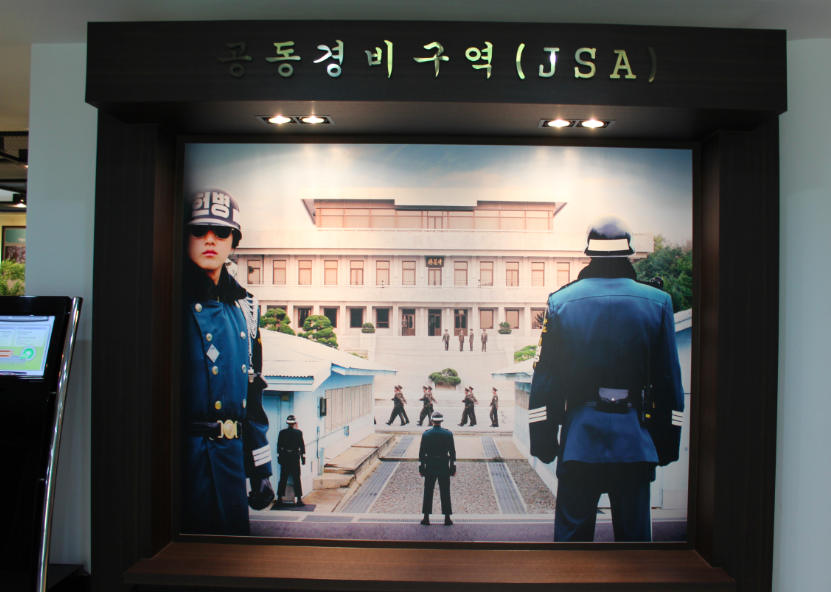One of my favorite moments in Seoul was stumbling upon a little art festival hosted by the Jogyesa Buddhist temple. I had been wandering through the markets of Insadong weaving through all this:
...when I came across this beauty of a temple.
Jogyesa temple sits right in the center of Seoul
I have always wanted to see giant buddhas, ever since studying art of the Silk Road. At last! Three slightly smiling giant golden figures sat before me, grounded and strong. Colorful paper lanterns hung overhead, bags of soil, fresh fruits and flowers filled the interior. The entire temple grounds was full of life and color.
Then randomly an English speaking girl sitting outside the temple encouraged me to join a dozen little old Korean ladies for some art crafting. She directed me to a table where I was instructed to paint and gold leaf a notebook. Communicating involved lots of giggling, smiling, nodding. I was clearly out of place, though quite welcome. Pleased and bewildered to find myself in this unlikely community, it was fun to take a break from the movement of travel to create something by hand.
It is very special to have a Westerner join us here, the English speaking girl said. She wanted to take my photo.
Voila, my little lotus flower notebook
This same generosity and kindness is all I've felt since arriving in Seoul. It was very different from what I felt in the north.
“Most people are on the world, not in it––having no conscious sympathy or relationship to anything about them––undiffused, separated, and rigidly alone like marbles of polished stone, touching but separate.”
Visiting the Korean Demilitarized Zone (DMZ), a 2.5 mile strip between North and South Korea was a strange way to end our time in the country. Quite the opposite of our entire trip, which was so gentle, hospitable, and kind. Here for the first time all week, rudeness slapped me in the face in the form of a condescending American military soldier.
At first the structure of the trip felt like a visit to Disneyland, only instead of waiting to enter a happy place, we descended into an embarrassing charade of hypocrisy thanks mostly to our American guide.
I'll be the first to admit, the concept of visiting an active war zone as a tourist is not my preferred activity. Yet we were recommended this tour as a way to better understand the country's history.
The heavily militarized border seems to be a present day display of saber rattling. Please, by no means am I belittling the pain and injustice suffered by those affected in the Korean War and it's aftermath. I have great respect for those who sacrificed their lives. What I had trouble accepting about the tour was the way in which the whole experience was presented.
We were welcomed with a fear-filled monologue––delivered by a youth drunk on power––saying that if he catches us taking photos, he'll rip our camera apart and we'll never see it again. Here's the kicker, he says, we better be prepared to sign our life away since we very well may die today on this tour in an active war zone. In the last few weeks North Korea has been agitated, threatening to attack us, he says. And you better believe that the first place they'd strike would be right where we are on this tour bus.
Before setting our sights on the border, we watch a propaganda-filled briefing about the Korean War. Among other things, it includes a few descriptive stories about how the Northerners attacked us, unprovoked in the middle of the DMZ zone. Then we are indeed each given a waiver that we must sign stating our consent to die on this visit.
A little toy reenactment of the 1976 Axe murder incident that took place in the Joint Security Area neutral zone
I don't doubt that there is some degree of truth in these stories and genuine risk in visiting a military zone. But I can't help but wonder just what the US government is after by offering this tour. Are they trying to win hearts and minds? If so, they may want to consider the image of the American military here, especially in front of international tourists.
The bus drives us through active mine fields to the border vista site while our guide proceeds to narrate what I find to be a derogatory, negative, racist, arrogant, violence-filled explanation of the purpose of the DMZ zone today. What a picture he paints, slandering North Koreans, teasing them because they're short. Making fun of women. There is not one good word that spills from his mouth. He's most interested in propagating hate, promoting the idea that this war is still going on and it's "us" against "them." It's not too surprising that I later come across this article about how South Korean youth today find the US occupation irrelevant and archaic.
We line up in two single file lines and are marched right out to the border of North and South Korea. Here we're told we can now take all the photos we want of the North, but we absolutely can't take photos of the South. There are a handful of soldiers with their backs facing us standing in a black belt fighter stance. We're under surveillance and everything we see and do is being recorded by North Korea, our guide says disdainfully.
Looking to the North
This all feels hypocritical seeing as we are onlookers doing just the same thing. The American building behind us mirrors the North Korean building, equally equipped with surveillance cameras. The military is indoctrinating our civilians just the same, cultivating animosity and justifying their war.
Why play the bully? Bullying in no way reflects the gentle, peaceful respect I experienced otherwise throughout South Korea.
A reminder of where we come from is necessary every once in awhile.
As for me, I prefer the peace, community, and beauty of buddha, and would have liked to end my trip on a better note, perhaps with the opposite side of this story. But contrast enhances perspective, does it not?




















